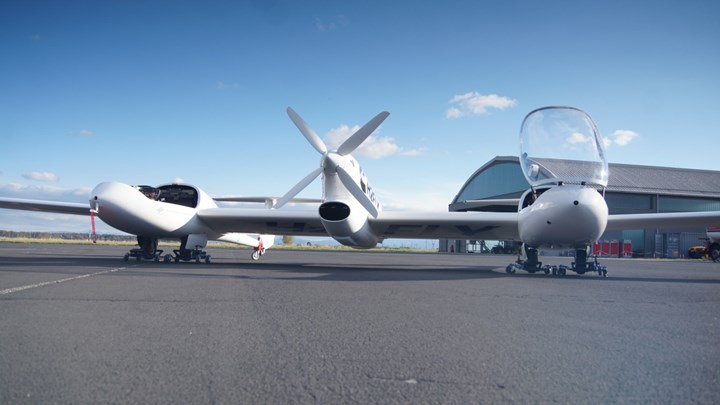Hydrogen fuel cell-powered HY4 aircraft takes flight
MAHEPA consortium demonstrates feasibility and advances toward liquid hydrogen tanks and scaling modular HY4 technology to new, emissions-free aircraft.

Hy4 hydrogen fuel cell-powered aircraft. Photo Credit: MAHEPA consortium.
The MAHEPA (modular approach to hybrid electric propulsion) consortium is proud to announce that technology developed as part of this project has been successfully proven in flight on board the HY4 aircraft. The consortium comprises Pipistrel Vertical Solutions, Compact Dynamics, DLR, H2Fly, Politecnico di Milano, TU Delft, University of Maribor and University of Ulm.
In November 2020, despite the COVID-19 repercussions and with all safety precautions in place, the HY4 hydrogen-powered, hybrid-electric aircraft successfully flew from Maribor airport in Slovenia, achieving a landmark milestone for the MAHEPA project and for the future of clean aviation. By demonstrating technologies and showcasing that long-endurance and safe zero-emission flights are possible, MAHEPA is creating the technological foundation to enable clean, quiet, safe and sustainable flight — making the Europe Green Deal goals for aviation one step closer to reality.
Pipistrel Aircraft platform and hydrogen storage
According to a Dec. 11, 2020 avweb.com article by Paul Bertorelli, the HY4 aircraft appears to be based on Pipistrel Aircraft’s (Ajdovščina, Slovenia) innovative Taurus G4, which married two of the company’s electric gliders into a twin-boom platform with a single electric motor in the center section wing. The G4 won the $1.35 million NASA Green Flight Challenge award in 2011.
According to Bertorelli’s article, project leader Josef Kallo describes the HY4 as a sixth-generation hydrogen drive that uses a fuel cell to power a single 160-hp electric motor for a top speed of 108 knots and range of up to 900 miles. Test flights began in November and more than 30 takeoffs and flights of up to two hours have been completed.
As can be seen in the video below, initial storage is a carbon fiber reinforced-plastic (CFRP) Type IV tank for gaseous hydrogen at 350 bar. The current HY4 website shows a storage capacity of 10-21 kilograms of hydrogen, as well as plans to move to liquid hydrogen for increased range. Composites are also visible in the airframe construction.
Future development
MAHEPA states that with the renovated and optimized fuel cell system technology developed in this project, and in strong cooperation with multiple national projects, the HY4 has become the most powerful hydrogen fuel cell-driven aircraft made to date. First qualification tests and data dissemination show that the redundant HY4 powertrain architecture allows an upscaling of the modular technology to megawatt (MW) scale. The H2Fly website shows future “upscaled” designs, including a hydrogen air taxi, a 6-19 seat aircraft and a 40-seat air transport vehicle.
MAHEPA claims an important technological achievement is the elaboration of first qualification test procedures for the hydrogen fuel cell aircraft. The project states this is the right track in the direction of commercial aircraft adaptation and its encouraging technological achievements can be used in future activities.
Much work still remains, however, including, as explained by the DLR video below, development of liquid hydrogen tanks, finalized aircraft configurations and refueling infrastructure.
Related Content
-
JEC World 2023 highlights: Recyclable resins, renewable energy solutions, award-winning automotive
CW technical editor Hannah Mason recaps some of the technology on display at JEC World, including natural, bio-based or recyclable materials solutions, innovative automotive and renewable energy components and more.
-
ECOHYDRO project to enable recyclable composites for hydrogen storage
With the involvement of two schools from the Institut Mines-Télécom, the 4-year project aims to improve the intrinsic properties of a composite material based on Elium via four concrete demonstrators.
-
Hexagon Purus opens new U.S. facility to manufacture composite hydrogen tanks
CW attends the opening of Westminster, Maryland, site and shares the company’s history, vision and leading role in H2 storage systems.
















